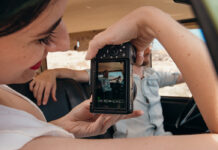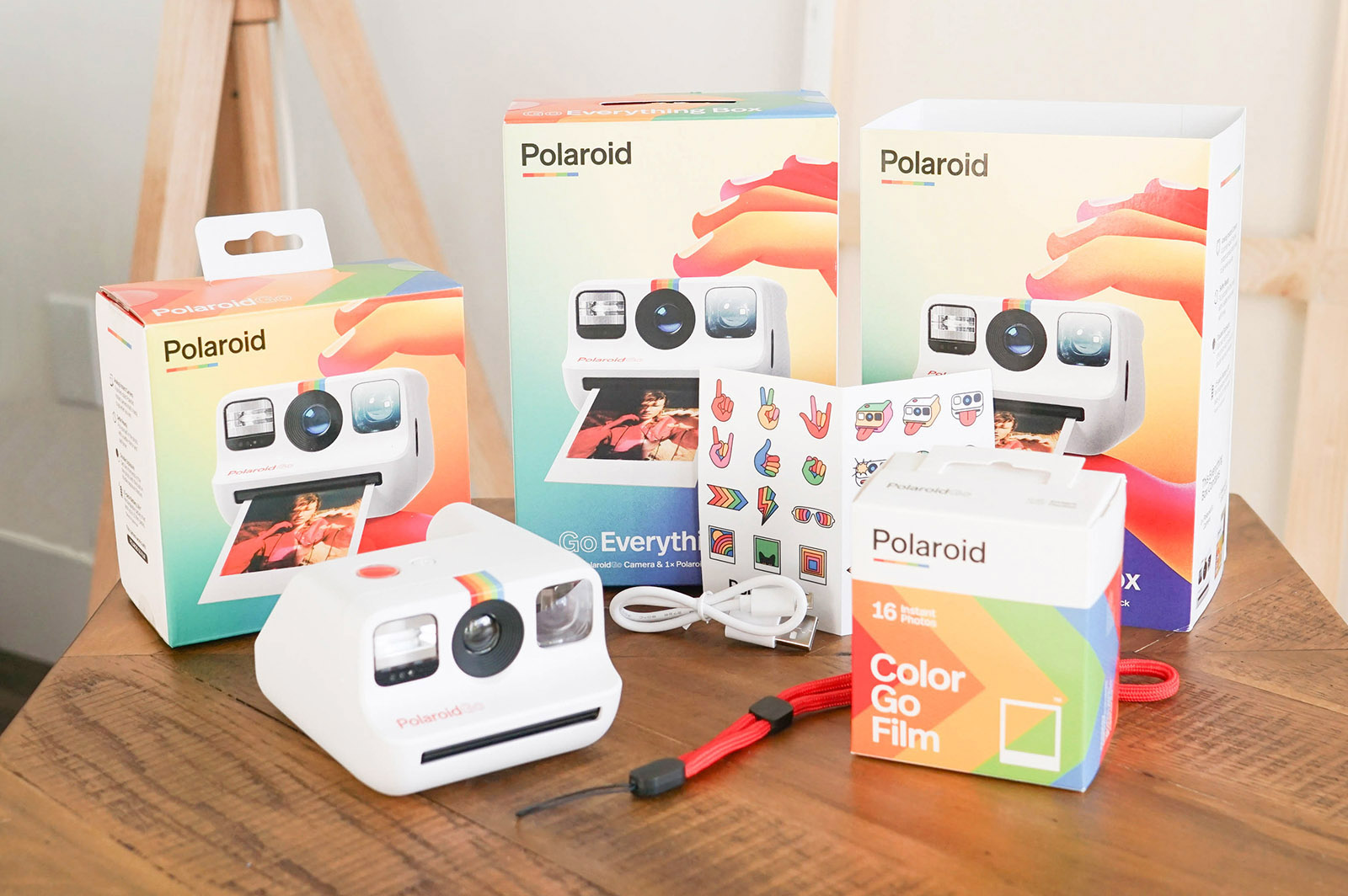
Everyone knows the Polaroid brand, but how many people out there have actually used a Polaroid camera recently? With the Polaroid Go Instant Camera Everything Box, the brand hopes to change that—and I think they’ll succeed. This compact camera combines the brand’s well-known vintage aesthetic with affordable mini film and a durable, lightweight camera body. The result is something wonderful that feels both old world and new.
What’s included in the Polaroid Go Instant Camera Everything Box?
The Polaroid Go Instant Camera Everything Box contains a Polaroid Go Instant Camera and one double pack of Polaroid Go colour film. In each pack of film, you’ll find 8 sheets of film and a sheet of double-sided adhesive buttons to decorate with your photo for a total of 16 sheets of film.
In the Polaroid Go box itself (inside of the Go Everything Box), Polaroid includes wrist strap, a super cute pack of stickers, and a micro USB charging cable. The camera body features a built-in flash, a large selfie mirror, a power button, a multi-purpose flash button, a LED display, an offset viewfinder, a built-in film shield, and a red shutter release button. You can purchase the Polaroid Go and film separately, but you do get a nice little discount buying the Everything Box—and then you know you’ll be ready to take a photo right out of the box, which is perfect if you’re buying it for an event or as a gift.
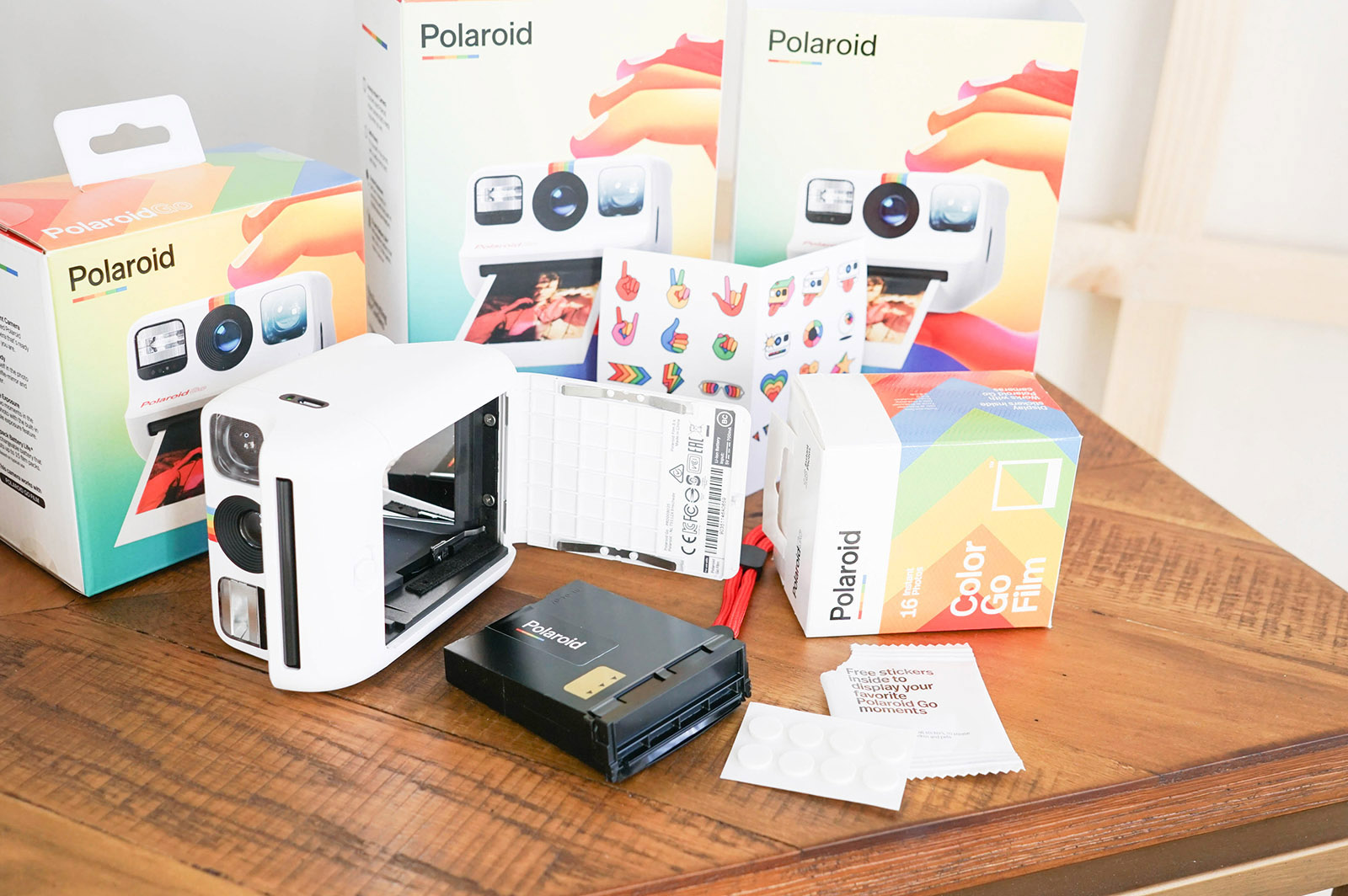
How the Polaroid Go Instant Camera works
Everyone has heard that one Outkast song line: shake it like a Polaroid picture.
Well, as someone who has reviewed instant cameras for years now, I’m here to beg you to please stop shaking your Polaroid pictures. Instant analog photos develop slowly, producing your photos through a light-sensitive chemical process. Shaking your photos can’t make the chemicals react any more quickly. In fact, shaking an analog photo of any kind as it develops can only disturb the image quality.
(It mostly doesn’t, as companies know to compensate for shaking and other disturbances in instant photography—but it is a risk! Shaking can smear the pigments in your instant photos as they develop making them blurrier than they should be.)
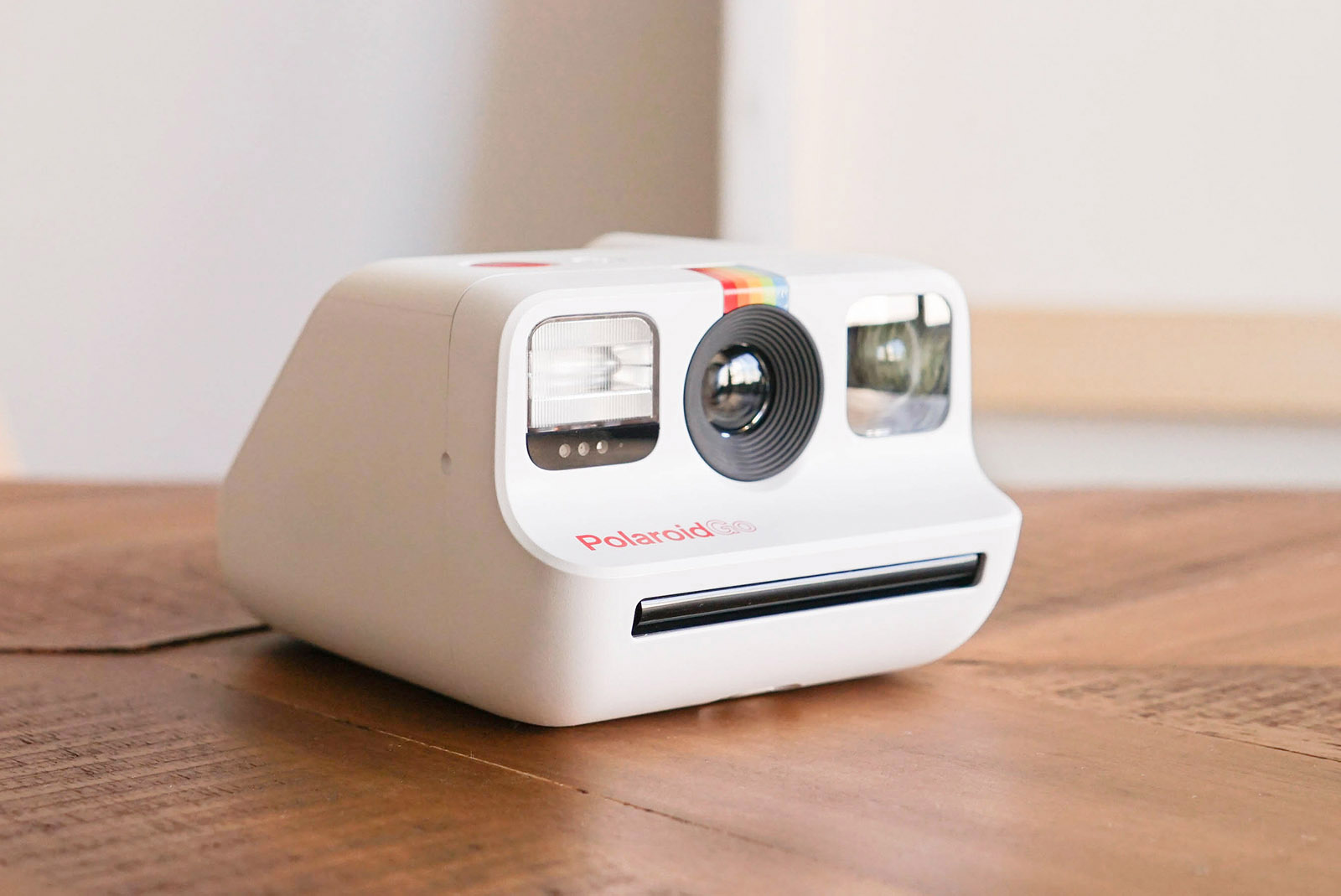
Taking a great Polaroid Go photo is actually pretty easy. You’ll want to turn on your instant camera, frame and snap the photo, and then wait for five seconds before gently removing the photo from underneath the camera’s film shield. Polaroid’s film shields are built in sturdily, and they’re something that I haven’t seen in an instant camera before. (This is my first real Polaroid!) They roll up into the camera body when not in use, but cover each new slide of film as it shoots out of the camera to make sure it’s able to develop properly.
I found that the film shield pops back into the Polaroid Go body so forcefully that it does actually disturb the pigments on each new photo—but the slightly smeared lines aren’t permanent. You don’t need to lift the shield gingerly; just gently. Each photo will develop as it should if left to develop in a dark place for about five minutes. (I just put them upside-down on a tabletop to finish developing, which works well!)

How to get the most out of your Polaroid Go Instant Camera
One interesting thing about the Polaroid Go is that it has a very stripped-down design. On the camera body, you’ll only see three buttons: a red shutter release to take the photo, a power button to turn the camera on, and a flash button. It creates a really pleasing, vintage aesthetic.
What you might not realize if you picked up the Go off of a table or shelf and just started snapping away, however, is that the flash button actually acts as a setting control. One press turns the flash on and off. Two quick presses turns the camera onto double exposure mode. On double exposure mode, the camera’s small LED display (which usually shows you how many photos you have remaining in your film pack) will switch to say “1” or “2”. Only after you take both exposures will that slide of film come out.
For one last hidden feature, holding down the flash button turns on the camera’s self-timer. Once you turn it on and hit the camera’s shutter button, you’ll have 9 seconds to get into position before the shutter goes off. It’s perfect for Polaroid group photos on the go, and can be turned off by holding down the flash button for another 2 seconds if you change your mind. You can take a timed photo with or without flash by setting the flash to on or off before setting the timer.
If there are more secrets to the Polaroid Go, I haven’t found them yet… But feel free to leave any others in the comments section of this post so that we can all enjoy them!
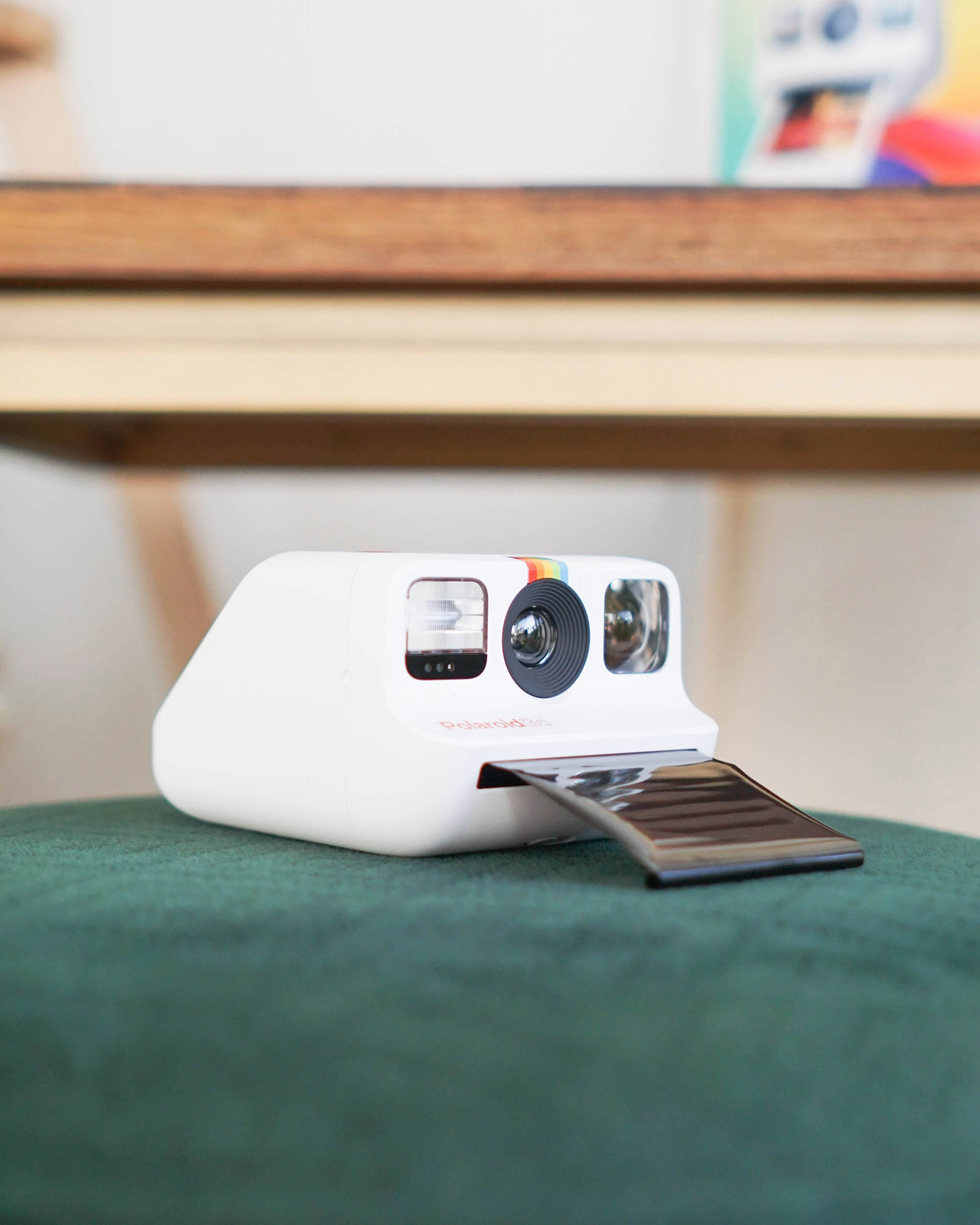
The flash on the Polaroid Go Instant Camera
The “look” of different types of film is always a little different. Some are punchier; some are grainier; some are more or less true to life. Unlike digital images, which look fairly similar and true-to-life no matter what camera you use, analog film changes the mood and texture of each shot that you take.
The Polaroid Go Instant Camera uses a smaller size of film than you might be used to from a Polaroid camera. Each slide is only 46 mm wide x 47 mm tall, with a classic white Polaroid border that takes it to 54 mm wide x 66 mm tall. It’s similar in size to Fujifilm Instax Mini film (46 mm wide x 62 mm tall), and much smaller than something like Polaroid 600 Film (107 mm x 88 mm tall). Price-wise, it sits a little toward the higher end of the market at around $1.87 CAD per slide.
Like with other types of instant film I’ve used, I found that Polaroid Go film created the most punchy results when used with flash. The camera’s small, powerful built-in flash helps to give depth to the images, offering a creamy centre with dark vignetting around the edges. To test this in different lighting conditions, I took the same selfie four times, but developed and set them a little differently each time. (It was surprisingly easy to mimic the same shot again and again: Polaroid’s built-in selfie mirror is generously sized and easy to use.)
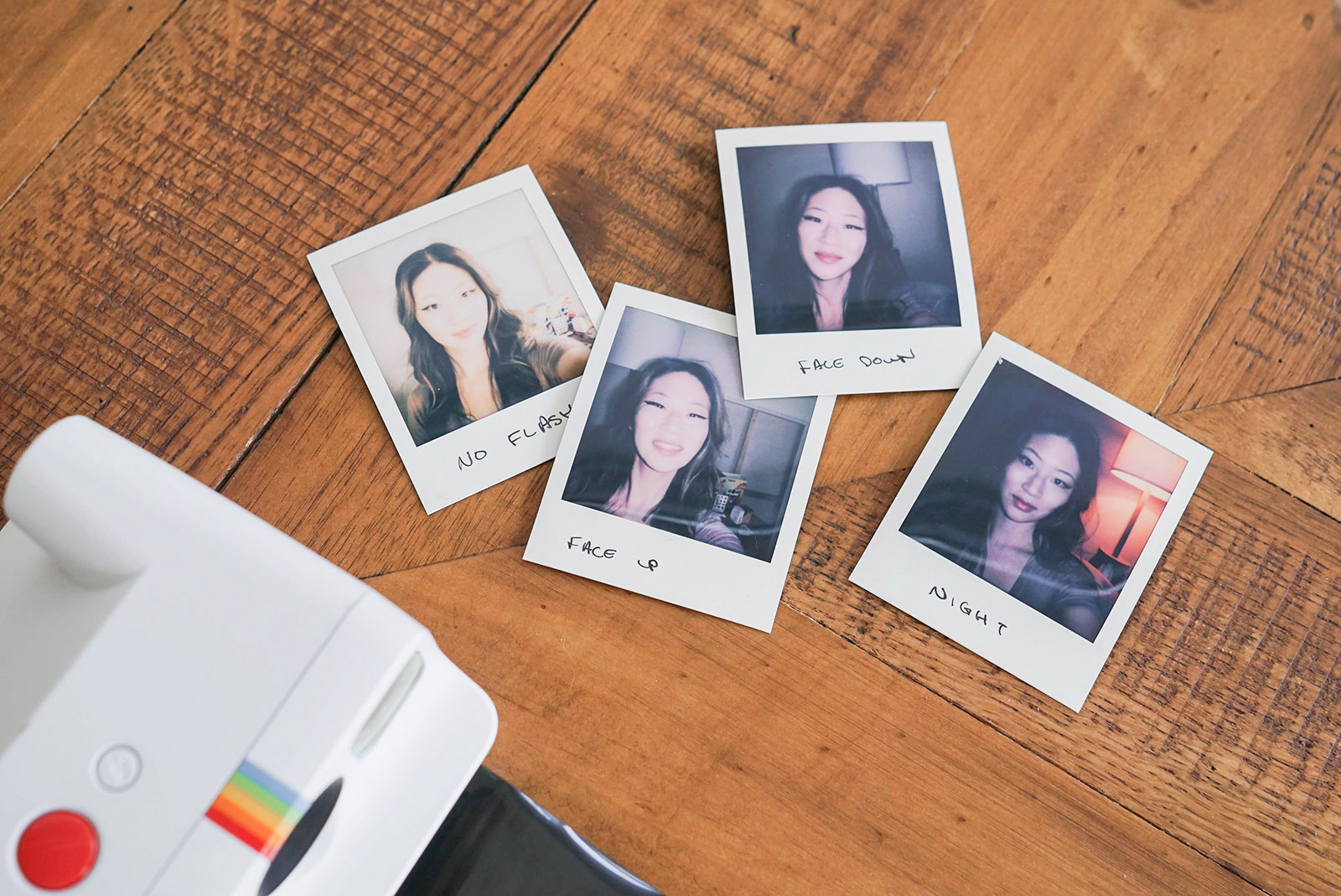
Polaroid Go flash comparison
- NO FLASH: Daylight: Washed-out vintage feel with good background detail despite the image’s small size
- FACE UP: Daylight with flash, developed facing up in the sunlight: A little washed out, but in a pleasing way. This shot developed nicely despite the bright conditions.
- FACE DOWN: Daylight with flash, developed facing down in the shade: Less washed out and very pleasing. I loved the creamy details and heavy vignetting in this photo.
- NIGHT: Flash on, dark room, light on in the back: Great contrast, excellent detail, and no overexposure for skin tones.
The film quality of the Polaroid Go camera
The Polaroid Go Instant Camera is smaller than a truly classic Polaroid camera, making it easy to take with you on the go. Its plastic body feels sturdy and lightweight, and I love that it’s available in both black and white.
From the Go’s clever one-button design to its punchy prints, I really loved using this funky little instant camera. It makes an excellent travel camera (especially for those who prefer an edgier, less bubbly aesthetic than other instant cameras available on the market) and would be a great gift for someone who loves documenting their adventures.
Shop the Polaroid Go Instant Camera Go Everything Box online at Best Buy.

